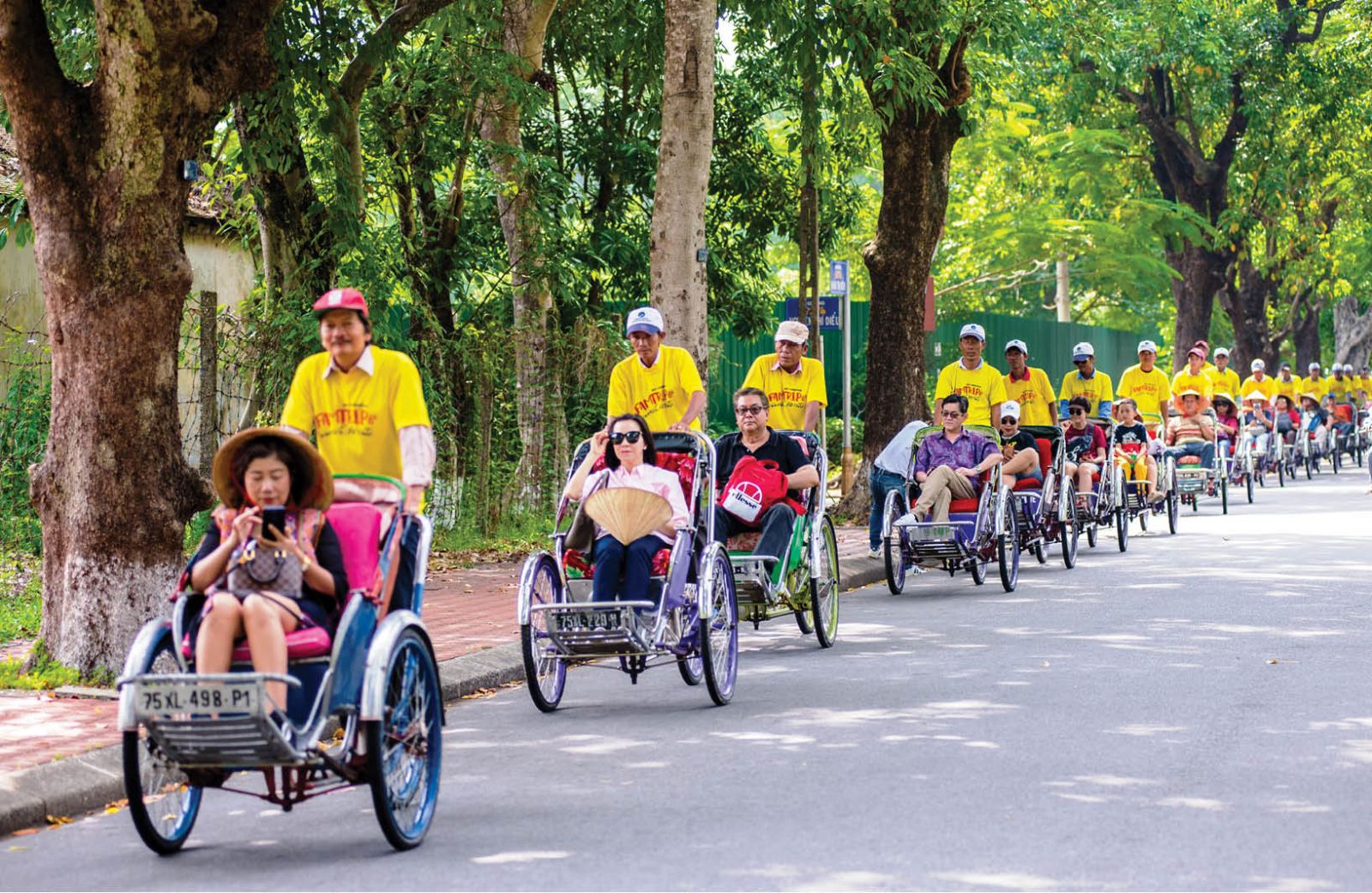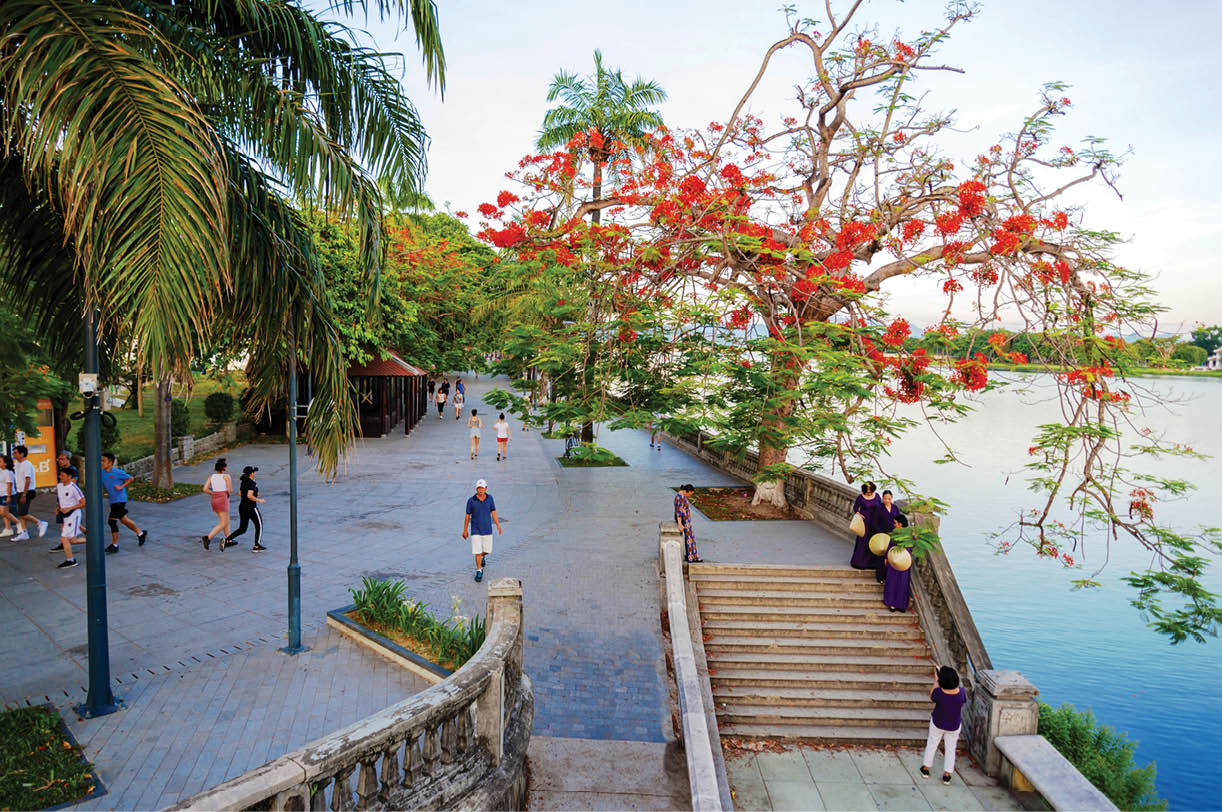Over the past year, hardly has a very big project been implemented in Hue, not to mention the historical households relocation of Thuong Thanh area. However, citizen and tourists still feel a transforming Hue.

Visitors to Hue will feel a green and friendly City
Hue "transformed"
Although Hue has not been perfect yet, many tourists show their interest and good feeling about Hue. Over the past year, hardly has a very big project been implemented in Hue, not to mention the historical households relocation of Thuong Thanh area. However, citizen and tourists still feel a transforming Hue.
Although it is just a brief comment on Hue by Mr. Tran Duc (Ho Chi Minh City), but it has broad implications: "You are no longer “conservative”, Hue people are now much more self-conscious. I see the streets are cleaner and more beautiful, and I know that behind that is a movement of scavenging that has had a positive effect”.
Hue not only has "Green Sunday" as Mr. Duc said, Hue knows how to take care of the Huong River with crystal clear water and the walking paths along the banks; take care of the park, of every office, and of every house, etc. The things seem very small but they bring great effects.
Although the historical households relocation of Thuong Thanh area is not a core factor for Hue to aim for building a Heritage City, it is of great value, first of all, to restore the value of the ancient city.
Referring to this factor, the researcher Nguyen Xuan Hoa said that Vietnam often feels guilty about the stature of the relics, that is, our country does not have any great historical relics of international stature, however, if once this relocation is successful, Hue Citadel will come out as a world-class architectural work.
This work has a circumference of more than 11km, 22m thick, 3-storey brick architecture with a system of 404 cannons, waterways, military roads, ancient observatory, imperial flag pole, etc., are still preserved intact.

Walking paths along the Perfume River creating ideal green space
Hue Citadel is of historical value and this households relocation brings even more real value. People have a new place to live with stable livelihoods.
In the past, living temporarily on the surface of the citadel wall, they did not know what to earn for a living but working as hired labor. But now, in the Huong So resettlement area (Hue city), many stores have mushroomed, and services are provided by the locals. Saying so to see that their power was released from the hold.
It is not exaggerated to say that Resolution 54 made Hue move quickly. There is a movement within the apparatus of the leaders at all levels of the government, the citizens and also the businesses. Many Hue people's start-up projects are based on heritage; Hue-S, Smart City, and so on not only change the appearance of Hue, but also contribute to the formation of positive consciousness of the people of the ancient capital.
At the moment, many people may not be very thorough about the difference in the future heritage city under the Central Government, but that goal is the driving force for development.
“If it is still Thua Thien Hue province, the motivation for development will be very weak and the strength of culture and heritage will be stalled. Recognizing the title Heritage City for Hue is not only confines to the heritage but also creates a development position in the new situation. In the past, Hue had traditional values, but now it must be a creative cultural center of academia, technology, tourism, etc. From cultural heritage to create development, seize golden opportunities," Mr. Hoa said.
Creating position and power
With the title of ASEAN cultural city, ASEAN clean tourist city, Festival city, etc., in order to affirm Vietnam's unique cultural center position, there should be mechanisms and policies to exploit the strength of the urban heritage. In addition to developing high-tech agriculture, building a strong science and technology center, specialized medical services, attracting talent, etc., sustainable tourism development is still a key economic sector. Obviously, the development of tourism is closely related to urban development policies.
.jpg)
Hue’s streets are clean and beautiful, shaded with green trees
In a speech at the workshop on constructing Thua Thien Hue to 2030, with a vision to 2045, the Tourism Development Research Institute - Vietnam National Administration of Tourism gave a startling number: The number of international visitors to Thua Thien Hue is only one-third of Hanoi, a quarter of Ho Chi Minh City, equal to 60 to 70% compared to Da Nang or Khanh Hoa, especially the total revenue from tourists is also very low.
“We should not compare with ourselves over the years, but with provinces and cities that are poorer [sic] in culture and heritage. From there, we can find new and more breakthroughs in the future,” Nguyen Dac Xuan, a researcher, expressed his opinion.
According to the General Department of Tourism, Thua Thien Hue has enough potential to become a major tourist center of the country. However, the development of tourism has a close relationship with urban development policy.
To clarify the identity of Hue city being the exact "competitive point" is very essential to ensure the sustainable development and long-term attractiveness of the destination. In addition, it is necessary to have solutions to attract new markets, develop new products; but ones must be cautious and appropriate to the situation, at the same time, enhance tourism linkage and further application of technology solutions.
With the Resolution 54 of the Politburo, one of the important immediate goals of Thua Thien Hue is to complete Hue city expansion according to the plan before 2022.
According to the planning scheme, Hue city will be expanded and completed according to the spatial axis of the Huong River connecting the mountain to the sea. The heritage urban core zone will be decompressed by the development of small towns on the two banks of the Huong River. Around Hue city center is the four auxiliary urban areas of Tu Ha, Huong Thuy, Thuan An, and Binh Dien.
“Hue urban planning is to identify specific development areas. If the upstream Huong river has landscape value; the central area has the Citadel, historic quarter, new quarter; downstream Huong river has ancient villages, craft villages, etc. From there, characteristic factors can be determined and investment can be conducted. The biggest difficulty now is the issue of capital. Now that when it is implemented, it is necessary to have a strict monitoring mechanism; the province is also making efforts for this issue. There are plans, though very optimal, the resource factor would decide all,” said Deputy Director of the Institute for Development Studies, Dang Minh Nam.
Urban development and conservation both have contradictions. In Hue, it is the contradiction between tradition and modernity, between a quiet culture and creative dynamism.
The problem does not stop at building good content, but has to find the position and power that is good enough. And if, once Hue is recognized by the Central as a Heritage City, more specific projects are needed to achieve an efficiency that meets the set-up criteria. This will promote the value of the heritage without causing new urban crisis to expand in the future.
Story: Le Tho
Photos: Dang Tuyen